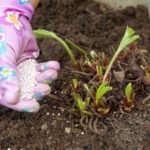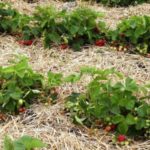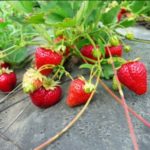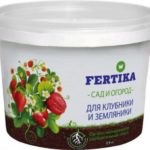All gardeners and gardeners begin to develop their plots with the planting of strawberry (common people called strawberries). Strawberry berries open fruit season, they are tasty and fragrant. They are loved by adults, but especially children. Growing strawberries is seemingly simple, but troublesome.. The plant needs constant care, especially attention should be paid to strawberries after harvesting.
Table of contents
General rules for caring for strawberries after harvest
With the harvest of the last berries, the preparation of the strawberry bushes for the next year’s harvest immediately begins, as with the arrival of spring of strength for the growth of young foliage, the strawberry takes flowering and fruiting from the accumulated stocks of last year’s season.
therefore the struggle for the next harvest should begin immediately after the current harvest and it consists in that before winter strawberry bushes have time to build up a good root system and stock up on nutrients.
To do this, immediately after harvesting you must:
- if the beds with strawberries were covered with mulch material (straw, sawdust) it is better to remove it now, since it could have accumulated diseases and pests;
- weed beds with strawberries to remove weeds, because they take food from the soil;
- soil loosening it is necessary to perform under bushes and between rows for better air exchange of roots, it should be done carefully, trying not to damage the root system and at the same time it is necessary to spud strawberry bushes, sprinkling growing roots on the ground (the main thing is not to fill the heart);
- remove old foliage and extra mustache;
- do timely watering strawberry beds;
- feed plants;
- perform a series of treatments strawberries in order to avoid plant diseases and pest control.
- Autumn pruning of leaves of garden strawberries
- Loosening the soil under the bushes of garden strawberries
- Autumn feeding garden strawberries
Removing foliage and whiskers trimming scheme
Strawberries in the garden renewal of leaves occurs three times per season.: spring, summer and autumn. On average, the life expectancy of strawberry leaves is 60-70 days, after which they age and die.
Spring growth of foliage plays a major role for fruiting. In the period after fruiting comes the second stage of the formation of new foliage - this is the period of laying flower buds and the accumulation of nutrients of the future harvest. Autumn foliage is important for good wintering bushes.
Signs of aging leaves are the appearance of whitish, red or red spots on them. While the leaves die off naturally, they take away additional nutrients from the plant and deplete the plants. therefore preferably 2-3 days after the end of fruiting, remove old leaves from the otter bearing busheswithout damaging the growing young leaves and hearts.
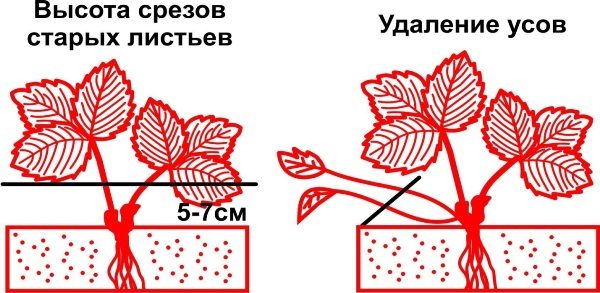
Along with the leaves, remove the extra mustache. If you need planting material to increase the strawberry plantation or replace old bushes with new ones, you need to leave the first outlet from the mother bush. It is the strongest and most productive. All the remaining grown mustaches are removed so that they do not deplete the mother bush, which is so weakened by fruiting.
As a result of mowing the leaves, we partially get rid of diseases and pests.populated by aging foliage.
Pruning produce pruners, if strawberry beds are not large. If the size of the berry plantations exceed the ability to process them manually, trimming process will help to perform an electric trimmer or gas mower.
Do I need watering in the fall?
The land on strawberry beds should be wet, since after fruiting and pruning the foliage, the plants should recover as quickly as possible, lay fruit buds, build up the root system. Watering should be abundant, at least once a week during dry periods.. In order to avoid sunburn of leaves you need to water in the morning or evening hours. After watering, loosening the beds is necessary to prevent the formation of a crust on the soil surface. To maintain the soil under the berry bushes in a wet and loose state, it is best to mulch the beds.
Mulching is the best way to preserve moisture.
The mulch soil becomes more friable. In the process of the decomposition of mulch in the soil, nutrients are accumulated and enriched with useful microorganisms. Mulching inhibits the growth of weeds, which facilitates the care of plantings. Berry beds look more aesthetically pleasing.
- Mulching of soil under strawberry bushes with straw
- Garden strawberries under black covering material
In the role of mulch you can use sawdust, straw, chopped dry grass (if there is a lawn, then after it is cut, grass should be dragged into the sun and spread out between the bushes and in the aisle), compost or leaf humus, pine needles. You can cover the ground under the bushes with spandbond (it is better to black, weeds practically do not grow under it) or to lay new plantings of strawberries at once on high ridges covered with black covering material.
Fertilizing after fruiting
In the post-harvest period, the strawberry bushes are weakened, all forces are spent on fruiting. To restore plants, stimulate growth processes and bookmark flower buds during this period, fertilizing is especially needed.
Experienced gardeners recommend feeding three times. Immediately after pruning the leaves in August, you need to feed nitrogen fertilizers to stimulate the growth of young foliage.. Two weeks after the first do fertilizing with organic matter with the addition of phosphorus and potassium, it will contribute to the establishment of flower buds. In mid-September, perform the third dressing solution of mullein.
Options feedings many choices for you. Uhthen there may be mineral supplements or organic.
Mineral
- Ammofoska - contains in its composition nitrogen, phosphorus, potassium, as well as magnesium, calcium, sulfur. Consumption 20–30 grams per 1 m2 in a dry form, sprinkle on the beds, then close up with a chopper into the soil and perform watering. You can water the bushes with a watering can by preparing a solution at the rate of 20 grams (matchbox) of fertilizer for 10 liters of water.
- Nitrophoska and nitroammofoska at the rate of 1 tablespoon per 10 liters of water.
- There are and special mineral fertilizers for strawberries containing all the fertilizer it needs.
- Mineral fertilizers for strawberry Ogorodnik
- Organic and mineral fertilizer mixture for strawberries and strawberries Fertika
- Water soluble fertilizer Crystal for strawberries and strawberries
Organic
- Mullein.
It can be worn both in dry form for mulching between rows, and as an infused solution.
To prepare the solution one piece mullein poured 10 pieces water, insist the mixture a day, after which the solution can be made under the plant. In this infusion, for enriching it with microelements, you can add one part of the ash.
- Bird droppings.
In the dry form under the growing bushes it is better not to make, because you can burn the roots and destroy the landing. For the preparation of infusion 1 part bird droppings are bred in 10 parts water and insist at least two days. Then, 1 liter of the solution is diluted in 10 liters of water and the plants are watered.
- Herbal Infusion.
In a barrel or other large container, grass is laid up to half the volume (weeds from weeding, nettles, mowed from the lawn), ash is added, water is poured all up to full volume and left to wander in the sun for 10 days. You can add 200 grams of yeast per barrel. They will speed up the fermentation process and enrich the extract with microorganisms. Ready infusion diluted in the ratio 1:1 with water and watered strawberry bushes. Infusion not only fertilizes plants, but also contributes to the deoxidation of the soil.
It is useful to make wood ash on strawberry beds, which is rich in potash-phosphate fertilizers and trace elements, helps reduce soil acidity. Bring ash after pruning leaves, produce watering and loosening the soil.
Fight against diseases and pests
After harvesting, it's time to start the fight against diseases and pests, because during fruiting this cannot be done. After pruning the leaves, strawberries are treated with a weak solution of potassium permanganate in order to disinfect the remaining petioles and tillage the soil under the bushes from fungal diseases.
If weevil is wound up on strawberriesthen the berry plantings are treated with the drug "Intavir" twice with an interval of two weeks. You can prepare an iodine solution: 10 drops of iodine per 10 liters of water and process plants.

To avoid damage to strawberry plantings with strawberry mite, plantings are treated with broad-spectrum insecticides (“Fitoverm”, “Fufanon”, “Aktellik”, “Kemifos”) immediately after harvest and in the fall.
When processing strawberries in tank mixes, it is advisable to add fertilizers, thus combining foliar feeding with the fight against diseases and pests.
Autumn care for garden strawberries, preparation for winter
Caring for strawberries in the fall consists in removing weeds and loosening the soil, mulching bushes and between rows with humus and foliage. Single sick and old leaves are removed from the bushes. It is impossible to cut the leaves drastically, the bush will not have time to grow the leaves, it will go into the winter weakened, it can not stand the cold weather and freeze.
From the frost, beds are covered with branches, dry foliage, and spruce branches. Covering with hay or straw is not worth it - mice can start and nibble on roots.
If you properly care for strawberry plantings after harvest, do not leave them to fend for themselves, then next year you will definitely have a bountiful harvest of sweet, aromatic berries. It will bring joy and pleasure not only to you, but also to your children and grandchildren.



